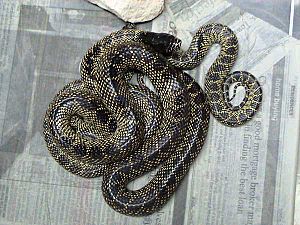Desert kingsnake facts for kids
Quick facts for kids Desert king snake |
|
|---|---|
 |
|
| Pair of desert kingsnakes, Lampropeltis splendida | |
| Scientific classification | |
| Genus: |
Lampropeltis
|
| Species: |
splendida
|
| Synonyms | |
|
Ophibolus splendidus Baird & Girard, 1853 |
|
The desert kingsnake (Lampropeltis splendida) is a cool species of kingsnake found in places like Texas, Arizona, and New Mexico. It is not venomous, meaning it's not poisonous. These snakes are usually colored yellow and black.
The desert kingsnake's diet includes rodents, lizards, and smaller snakes, even rattlesnakes. They normally grow 3 to 4 feet long, but some have been known to grow up to 6.8 feet! When they meet humans, they are often quite calm. If they feel scared and can't get away, they might even "play dead" by flipping onto their backs and staying very still. Some people, like ranchers, keep kingsnakes because they help by eating other snakes that might be dangerous. This snake was once thought to be a type of common kingsnake.
Contents
What Do Desert Kingsnakes Look Like?
These snakes have shiny, black or very dark brown backs. They are covered in tiny off-white or yellow speckles. These light spots often form faint, narrow bands across their backs. The areas between these bands are black.
Along their lower sides, you might see more pale yellow scales. The belly of both young and adult snakes is mostly black, with white or pale yellow patches. Their smooth scales are arranged in 23 to 25 rows around the middle of their body.
Where Do Desert Kingsnakes Live?
The desert kingsnake can be found in many different natural areas within its home range. Even though its name includes "desert," it often prefers wetter places. You are most likely to find them near water tanks or along riparian corridors, which are areas next to rivers or streams.
What Do Desert Kingsnakes Eat?
This snake is known to be a powerful constrictor. This means it squeezes its prey tightly until the animal can no longer breathe. Because of this, their diet mostly includes mice and other rodents if they are in the wild. They can also find and eat reptile eggs that are buried underground by smelling them.
Desert kingsnakes are special because they are resistant to pitviper venom. This allows them to eat young diamondback rattlesnakes, which are common where they live. If an adult western diamondback rattlesnake smells a desert kingsnake, it will often quickly back away, trying to protect its head.
Reproduction and Life Cycle
Like most reptiles, L. splendida lays eggs. Courtship and mating happen between March and June. The female snakes lay clutches of 5 to 12 sticky eggs in late June or July. Sometimes, they bury the eggs as deep as a foot to keep them from drying out.
After about 60 days of incubation, the baby snakes hatch. They are usually 8 to 10 inches long and weigh about a fifth of an ounce. When they hatch, they have bright yellow speckles in lines across their backs. They also have a row of large, dark brown spots along their sides. As they grow older, these brown spots slowly break up as more yellow speckles appear.

